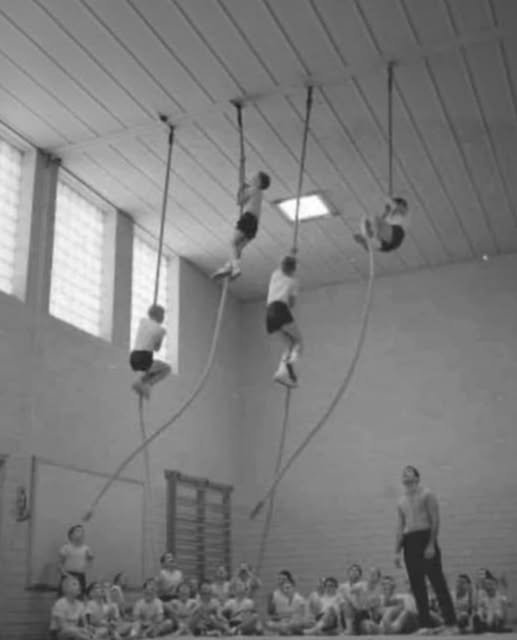For many who grew up in the late 20th century, the memory of scaling a towering rope in gym class—often with nothing but a wafer-thin mat below—remains etched in both muscle and mind. It was a test of strength, courage, and sometimes sheer survival instinct. This seemingly simple exercise was more than physical education—it was a cultural moment.
🏫 The Golden Era of Gym Class Challenges
From the 1950s through the 1980s, rope climbing was a staple in school PE programs, especially in the U.S. and parts of Europe. Students were expected to ascend 20 to 30 feet of thick rope, often using only their hands, while their classmates watched from below. The reward? A dusty ceiling beam tap and the pride of not plummeting onto the 2-inch-thick mat that barely cushioned a fall.
- Introduced in schools as part of military-style fitness regimens
- Olympic sport until 1932, judged on speed and form
- AAU and NCAA sanctioned rope climbing events until the early 1960s
😅 Risk, Resilience, and Rope Burn
The exercise was notoriously unforgiving:
- Rope burns were common, especially during rushed descents
- Fear of heights was rarely accommodated
- Safety standards were minimal—many recall mats held together with duct tape
Yet, for many, it was a badge of honor. Climbing that rope meant you were tough, capable, and ready to face the world—even if your palms were shredded.
🧠 Why It Disappeared
By the 1990s, rope climbing began to vanish from school curriculums:
- Increased safety concerns and liability risks
- Shift toward inclusive fitness and mental well-being
- Modern equipment standards demanded better protection
Educators began favoring activities that emphasized teamwork, cardiovascular health, and emotional safety over feats of brute strength.
🕰️ A Legacy of Grit
Despite its decline, rope climbing remains a symbol of generational toughness. It’s often referenced in nostalgic conversations, memes, and even Reddit threads where Gen Xers and older Millennials swap stories of gym class trauma and triumph.
💪 The Modern Take
Today, rope climbing lives on in:
- CrossFit and obstacle races like Spartan and Tough Mudder
- Military and police training
- Circus arts and aerial fitness
But it’s practiced with harnesses, crash mats, and progressive training, reflecting a more thoughtful approach to strength and safety.
For many who grew up in the late 20th century, the memory of scaling a towering rope in gym class—often with nothing but a wafer-thin mat below—remains etched in both muscle and mind. It was a test of strength, courage, and sometimes sheer survival instinct. This seemingly simple exercise was more than physical education—it was a cultural moment.
🏫 The Golden Era of Gym Class Challenges
From the 1950s through the 1980s, rope climbing was a staple in school PE programs, especially in the U.S. and parts of Europe. Students were expected to ascend 20 to 30 feet of thick rope, often using only their hands, while their classmates watched from below. The reward? A dusty ceiling beam tap and the pride of not plummeting onto the 2-inch-thick mat that barely cushioned a fall.
- Introduced in schools as part of military-style fitness regimens
- Olympic sport until 1932, judged on speed and form
- AAU and NCAA sanctioned rope climbing events until the early 1960s
😅 Risk, Resilience, and Rope Burn
The exercise was notoriously unforgiving:
- Rope burns were common, especially during rushed descents
- Fear of heights was rarely accommodated
- Safety standards were minimal—many recall mats held together with duct tape
Yet, for many, it was a badge of honor. Climbing that rope meant you were tough, capable, and ready to face the world—even if your palms were shredded.
🧠 Why It Disappeared
By the 1990s, rope climbing began to vanish from school curriculums:
- Increased safety concerns and liability risks
- Shift toward inclusive fitness and mental well-being
- Modern equipment standards demanded better protection
Educators began favoring activities that emphasized teamwork, cardiovascular health, and emotional safety over feats of brute strength.
🕰️ A Legacy of Grit
Despite its decline, rope climbing remains a symbol of generational toughness. It’s often referenced in nostalgic conversations, memes, and even Reddit threads where Gen Xers and older Millennials swap stories of gym class trauma and triumph.
💪 The Modern Take
Today, rope climbing lives on in:
- CrossFit and obstacle races like Spartan and Tough Mudder
- Military and police training
- Circus arts and aerial fitness
But it’s practiced with harnesses, crash mats, and progressive training, reflecting a more thoughtful approach to strength and safety.

